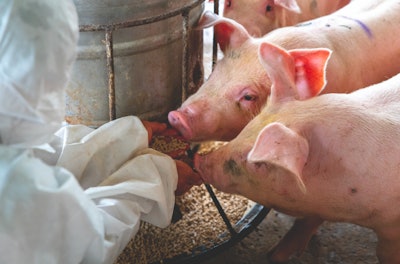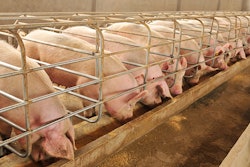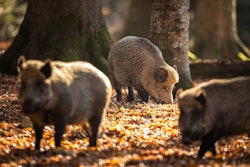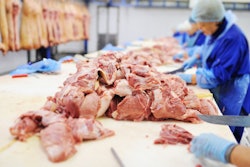
Kansas State University’s Megan Niederwerder talks about her newest work, published in the journal Animals
PODCAST: How to mitigate the spread of African swine fever in feed (14:07)
Ann Reus, Feed Strategy staff reporter: Hello and welcome to the Feed Strategy podcast. I’m your host, Feed Strategy staff reporter Ann Reus.
Megan Niederwerder is an assistant professor of diagnostic medicine and pathobiology in the College of Veterinary Medicine at Kansas State University. She has spent years researching how feed and feed ingredients can serve as vectors for viral disease in swine.
Megan recently published an overview in the journal Animals on the risk and mitigation of the African swine fever virus in feed. You can find a link to her newest work on our website at www.FeedStrategy.com.
Read “Risk and Mitigation of African Swine Fever Virus in Feed” in the journal Animals
Megan joins me now to discuss her research findings and help swine producers and feed manufacturers better understand how viruses might spread by way of feed and feed ingredients and how they can mitigate those risks.
Hi Megan, good to have you here.
Niederwerder: Hi, Ann. It’s so good to be here. Thank you so much for the invitation.
Reus: No problem. Now, feed isn’t the only way the African swine fever virus can spread. Can you explain the ways this virus can be transmitted?
Niederwerder: So, African swine fever virus actually has many different ways in which it can be transmitted. One of the ways that it can be transmitted is through direct contact with either commercial swine, or wild boar that are carrying the virus through nasal or oral secretions, or excretion such as feces or urine. It can also be transmitted through the ingestion of uncooked swill or food waste that contains uncooked pork products. And it can also be transmitted to the bite of Ornithodoros ticks. So, it’s not only transmitted through the sort of classic ways that we consider such as contact with other pigs and ingestion of contaminated pork products, but it’s actually also a vector-borne disease that can be transmitted by these tick species.
Reus: When it comes to contamination risks for feed, what are the main concerns?
Niederwerder: Yeah, so when we think about feed as a potential risk factor for African swine fever virus, and also other pathogens of swine, we can think about, first, how the feed ingredient may become contaminated, and in countries in which African swine fever virus is circulating, we can think about that potentially occurring through several different pathways. One of the pathways is through the pre-harvest, or the growing period, of plant-based feed ingredients or crops. If those crops have exposure to wild boar that are circulating or that are infected with the virus, those wild boar can contaminate those crops even prior to harvest.
Second, there are certain agricultural practices in some countries, such as drying grains on roadways, during the processing of feed ingredients, that could contaminate the feed ingredients as well, because some of those roadways may be shared with vehicles or trucks containing pigs that may be infected and maybe excreting the virus.
And then third, we think about sort of post-processing. So, we think about, can there be multi-use containers that are used to transport feed ingredients that may contaminate the feed ingredients if they have been exposed to infectious material? Or could the feed ingredients become contaminated during storage, either an unsafe storage where they have exposure to infectious pests, or through the contamination of, let’s say, personnel, or fomites, which may be contaminated with the virus. So, we can think about that feed ingredients have the potential to become contaminated at many different control points within the harvest, the processing and the post-processing of these feed ingredients.
Reus: In your article in the journal Animals, there’s a great flow chart that illustrates how to assess the risk of feed as a vector for viruses. Do you think we need to reconsider pig feed formulation or ingredient sourcing in countries that are free from ASF to limit that risk?
Niederwerder: Yeah, so I think one of the things that we have to start thinking about or continue thinking about is, one, knowing where the feed ingredients are coming from. Are the feed ingredients coming from countries that have active or circulating outbreaks of African swine fever virus? And then thinking about, is there a cost-effective alternative source that does not have African swine fever virus such as, could you source the feed ingredient locally in the U.S., or from another country that does not currently have outbreaks of African swine fever virus or other foreign animal diseases. So, first, knowing where your ingredients are coming from, and knowing the epidemiological situation of the country of origin, and knowing the risk factor of that country, I think, is really important to think about feed and feed mill biosecurity.
The second aspect of that is thinking about what you can do in your feed mill with regards to implementing biosecurity protocols. So, many of the biosecurity procedures and protocols that we have in place in swine farms can be directly translated to the feed mill environment, such as thinking about entry and exit protocols, changing shoes, changing clothes, having personnel restrictions with regards to where contact with swine, or travel to countries which may be at high risk for virus contamination, thinking about a line of separation from clean to dirty, a lot of these factors can be implemented at the feed mill to increase the biosecurity and the biosafety of those feed ingredients upon arrival.
The other aspect of this that we can think about is starting to look at what are the mitigation strategies that we can put in place for those ingredients which may be at high risk. So, storage protocols we’ve discussed, so is there a certain holding time which may allow the virus to decay within storage to reduce the risk of transmission to pigs? Thinking about heat treatment; so, we know that viruses decay at a more rapid rate, if they’re at higher temperatures, and then thinking about also feed additives. We’ve had some work done, or performed here at Kansas State University that we have shown that some feed additives can reduce the infectivity of African swine fever virus in feed. And, so, we can really think about all of these biosecurity protocols and mitigation strategies coming together to again try and reduce our risk as much as possible with regards to the risk of ASF introduction through this route.
Reus: Can you talk a little bit more about some of the feed additives that you’ve worked with and how they can work to reduce the spread of ASF and other viruses in feed?
Niederwerder: Sure, the two main classes of feed additives that we have worked with here at Kansas State University have been a formaldehyde-based feed additive, and medium-chain fatty acid-based additive. And so these two additives actually work to inactivate viruses with different mechanisms. And so we wanted to look at these two classes to understand their efficacy on African swine fever.
And so we looked at those two additives in in two different ways. First, we looked at can those additives when, when mixed with African swine fever virus, actually reduce the infectivity of the virus and at what inclusion rate? Were they efficacious? And then, secondarily, we looked at the these two feed additives in feed ingredients that are commonly imported, and looked to see if, one, they had an effect on the detection of ASF DNA through PCR. And also, did they have an effect on the infectivity of the virus in the feed ingredients? And, fortunately, what we were able to discover is that both feed additives actually are capable of reducing the infectivity of ASF in feed. Now, one of the important characteristics of these feed additives is that neither one destroyed ASF DNA, so we could still pick up the virus on PCR tests, but the virus was no longer infectious. So, I think that’s really important because as we talk more about the importance of feed as a potential route for entry, we have to start thinking about, how are we going to test these ingredients for surveillance, to know if there’s a potential contamination. And, in this case, the presence of ASF DNA did not indicate that the virus was actually infectious. And so this will be an important component to feed diagnostics moving forward.
Reus: Now, as you know, North America remains free from African swine fever. If the virus were ever introduced into the domestic pig population in the U.S., potential losses are estimated to be at least $15 billion. Given that huge risk, do you think the biosecurity measures and procedures that we have in place now are enough?
Niederwerder: Well, I think that in most cases, we can always do better with biosecurity because we are also dealing with, of course, endemic diseases. There are swine herds that have PRRS outbreaks have PEDV outbreaks. And a lot of the biosecurity procedures and protocols that I’m talking about with regards to both swine farms and feed mills will be broadly protective against both endemic viruses as well as foreign animal diseases. And so, when we talk about biosecurity and implementation of some of these protocols, it comes up, of course, the cost associated with implementing these procedures. And so we, of course, always have to balance what biosecurity protocols and procedures are going to give us the best outcome or reduce the risk of introduction of a new disease, to the greatest extent, and so making biosecurity most cost effective. But when you compare that to the numerical or the economic losses that would be associated with the introduction of African swine fever, as you mentioned, between $15 and $50 billion, you can see that, you know, the cost of biosecurity is really what we’re doing to reduce the risk of this foreign animal disease from being introduced, which would be extremely costly. And so, implementing a lot of these policies and procedures with regards to feed ingredients is another way in which we can protect the swine herd, and hopefully translate that to an overall improvement in health from both endemic and foreign animal disease risk of introduction.
Reus: So, in your opinion, how can we best mitigate the spread of viruses on pig farms and in the feed mill?
Niederwerder: So I think one of the things that first thinking about is, of course, on the swine herd side, thinking about the biosecurity protocols and procedures that you have in place, and then talking with your feed mill about the biosecurity procedures and policies that they have in place to protect the feed ingredients and to make sure that the feed is as safe as possible prior to arrival on the swine farm. And so talking with your feed mill, understanding where feed ingredients are coming from, knowing if there is a cost-effective and suitable alternative for high-risk ingredients, looking at what ingredients may be at highest risk and thinking about, can we source these locally, is it cost effective to source these from the U.S.? Thinking about storage protocols: If there are high risk ingredients, are they being stored prior to being integrated into the swine diet? And also thinking about, potentially, the use of feed additives to reduce those risks? So a lot of the things that we’ve discussed can be integrated into a comprehensive biosecurity plan for the feed mill as well as, you know, secondarily to the swine herd. And so, thinking about these policies and really integrating them together, becoming more knowledgeable about where the feed ingredients are coming from, and how to reduce those risks, I think, are really important.
Reus: All right, well, thank you, Megan. This was all really interesting. If you’d like to access Meghan’s newest paper in the journal Animals, there’s a link to that on www.FeedStrategy.com. Thank you, Megan, for talking to me today.
Niederwerder: Absolutely. It was a pleasure to talk with you and thank you again for the invitation. And thank you for making the article accessible to all your readers.
















